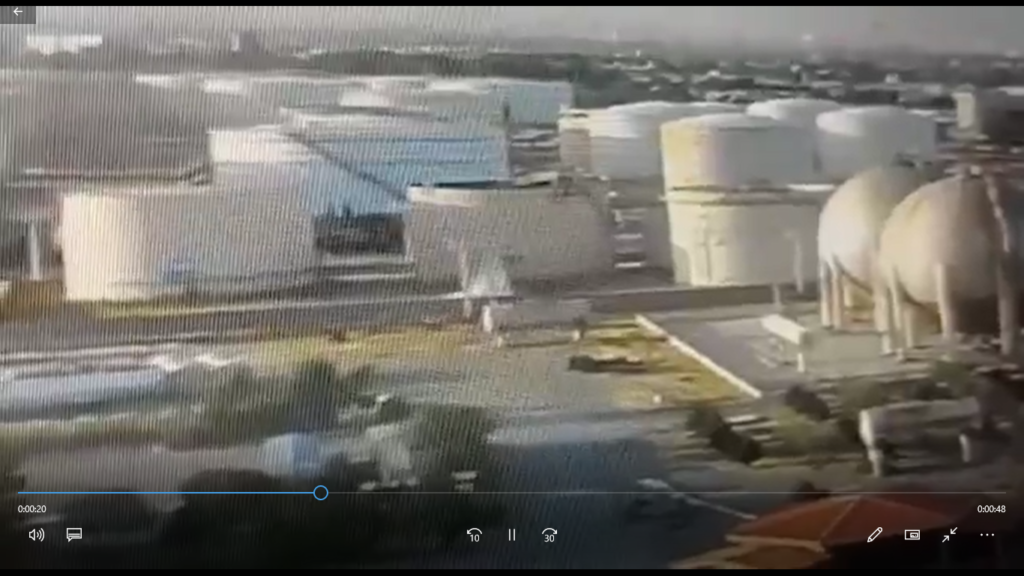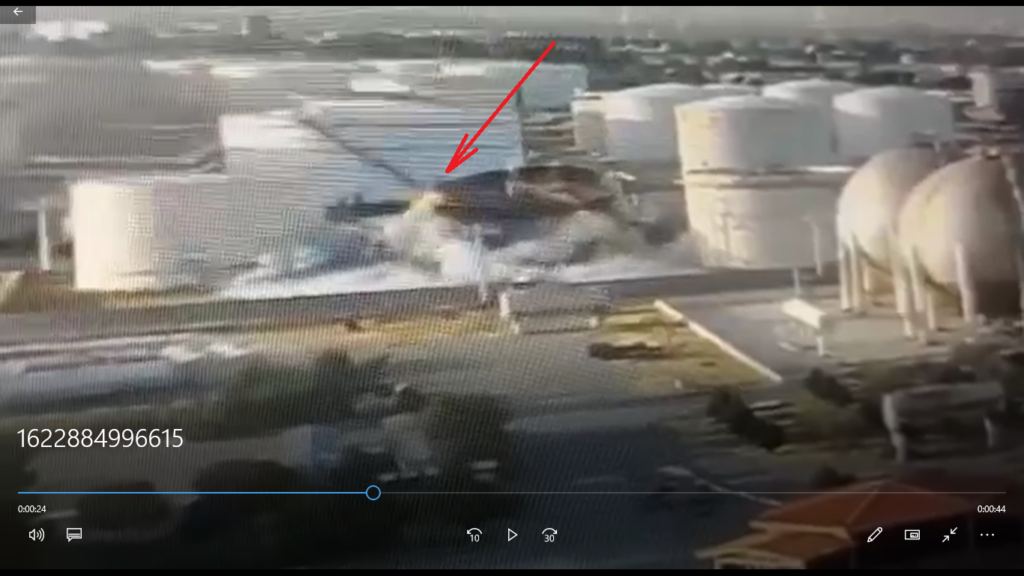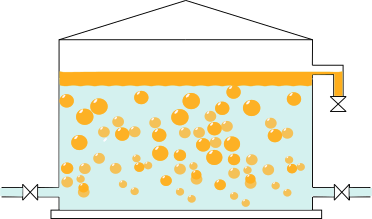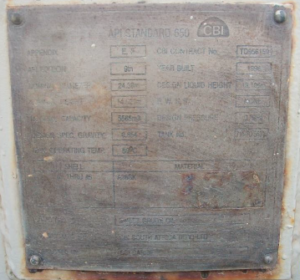In wednesday 2, June 2021, a fire erupted at the state-owned Tondgooyan Petrochemical Co. to the south of Tehran. The Oil Ministry’s SHANA news agency said it was caused by a leak in two waste tanks at the facility. Authorities initially suggested the flames affected a liquified petroleum gas pipeline at the refinery. (Source)
The objective of this post is to shed some light in which could be the causes of the failure in the tank. I want to risk my opinion on this accident because I want to clarify some things that have been said. Also it is an unique opportunity because not every day you see video footage of a tank failure so clearly.
I don´t claim to have the truth in this case, but I will tell my conclusions anyway.
Before reading the next lines, please check the video below.
The tank is an external floating roof tank type with rolling ladder. It is atmospheric.
What was the cause for this mess? The comments in linkedin were many and varied. Very respected engineers said that it was a lack of third party inspection. A big portion of the comments said that it was lack of maintenance. Still others said that the thank was just too old to be still in service.
How could this people come to such different conclusions? Let´s see some possible explanations.
BRITTLE FRACURE. Ambient temperatures in Iran in May are not so cold. This reduces the possibility of brittle failure. However, we cannot discard it as a cause.
TANK AGE. Tank age could have something to do, because throught the years, the tank corrodes in several parts and loses capacity. However, a tank can be suitable for the same service eternally, in theory, if it is inspected with a correct frequency, repainted and protected by a cathodic protection system. I don´t know about the Iranian construction standard, but I don´t think there is any part of it that limits the age of a tank.
REGULAR NDT AND INSPECTION. I assume that the tank had an inspection in the last 10 years. This would reduce the chance of corrosion defects in the inside of the weld. Regarding NDT, the following question arises. Should we conduct 100% NDT over horizontal welds every now and then? It is difficult to conduct NDT over an horizontal weld, because it would be prohibitively expensive. If the tank failed because of lack of ULTRASONIC inspection of the horizontal weld, then we are all doomed, because that would mean that we need to stop the operation of every tank around the world right now just to make sure that the horizontal weld is safe.
No. The best option is to trust the construction proccess and the construction records, which is the tricky part. A tank´s construction proccess involves the making of an hydrostatic test that proves that the equipment will operate for the intended service and level. But because of the high cost of the test, sometimes the contractor will try to avoid it or make it with less water, recording a higher level in the reports than it was actually made.
In this case, the clues to the solution of the mistery are in the video itself.
Let´s check some of the frames of the video.
00:06. Lack of contention can be seen. The pattern implies and failure mode that is horizontal

00:20. The Flow increases

00:22 The horizontal Weld unzips

00:26 There is a spark at the top of the Shell inf the left side, which coincides with the top of the inclined floating roof

This is what I think happeneD.
1. The tank failed at the maximum level. This is evident in the position of the rolling ladder, way up. That is bad operation and one of the main reasons of this accident. Maybe there was a mechanical problem with the valves or the level measuring device, or the operator just forgot.
2. Also, there must have been poor workmanship during construction, because it is not expected that the horizontal weld fails rather than the vertical. This signals to several possible mistakes that an on-site investigator should be able to pinpoint. You can see that there is an horizontal attachment to the shell (Unless, of course, that there is corrosion in an horizontal plane, be it at the weld or at the shell). Maybe it was welded without respecting the distances. This added to the fact that maybe there was a change of service to a more severe service without a torough analysis, or maybe the hydrostatic test wasn´t performed correctly or at all. The hydrostatic test reduces the risk of failures during change of service also.
We don´t know. But it is evident that someone did a bad job.
3. Lastly, the spark generated because the roof, I would bet, was not grounded to the rest of the tank and to the terrain, generating a difference of voltage between the roof and shell. Sparks by electric cables are another possibility. A good grounding system is an additional protection layer for a tank, because even if it fails catastrophically, there could be no fire.
I don´t think bad inspection is to blame. Usually there isn´t any information and nobody knows nothing of nothing about they equipment work with on a daily basis. In conclusion, as with any other accident, the overall integrity program and IOW program failed.
AFTERMATH OF THE INCIDENT
What are the implications of this for the Tehran Oil refinery? Well, this implies that operation personnel must be trained again in the risk associated with old tanks. A portion of the risk in a tank is due to the lack of information or information fraud.
This also implies that inspection plans for all of the tanks in this facility (or at least by the same contractor or made in close dates) must include from now on a percentage of inspection of the horizontal welds of the tanks, which is not common during normal inspections. The revision should include all the tanks built BY THE SAME CONTRACTOR. This NDT requirement is only because foul-play is suspected.
Operator, owners and inspectors around the world must keep construction, maintenance, repair and inspection records up to date. Also it is neccesary that from now on operations personnel take inpsection duties, which they don´t like. They must be trained in the use and inspection of protective measures for tanks. This includes lightning and electrical discharge protection. Usually, operators, inspectors and maintenance personnel don´t work together.
I have seen some recent headlines informing about how the new construction standards allow for the exception of the hydrostatic test. I can understand this, because technologies are advancing very fast. You can, in theory, control all of the variables during a construction proccess for many tanks, keep them the same and test just one hydrostatically, and extend the test conclusion for the others. But this was not the case 10, 20 or 30 years ago.
The best option is to keep a good integrity program which includes an IOW program so this accidents don´t happen so often.
IF YOU WANT TO KNOW MORE ABOUT A COURSE TO PASS THE API 653 INSPECTION EXAM, CLICK HERE
Regards.
Carlos Molina
What are the implications of having piping fixed /attached to the tank during the hydro test? Is this at all acceptable?
Answer
As new tanks can settle, it would be risky to attach the piping before the hydrostatic test. The tank can go down, that way introducing stresses in the nozzles and surrounding equipment if it exists (pumps, for example).
It is not acceptable. Maybe in an older tank where you already know if the tank will go down or not. But it is not recommended neither.

Let’s make decisions according to risk .
If a tank starts to tilt or settle, we are talking of thousands of liters of water you need to take out before you can remove the piping. That’s one day or two of reprocesses and cost of water transport.
There is also the risk of damaging the tank. Tank shells can be deformed. Fillet welds can crack. The risk is real.
On the other hand, the cost of putting some blinds in the nozzles is minimal.
The blinds can even be made by the contractor.
That’s one case where a big risk can be eliminated with cheap actions. It is better for everyone to have peace of mind.
The combination Spaced repetition training and the 653-FIX ebook questions can make you pass your API 653 exam ath the first try. Check it here
Question: According to API 653, reconstructed tanks require a nameplate showing the appropriate info associated with the re-construction. What about simple repairs and/or alterations of a shell, bottom, roof or nozzle? Do they need tank nameplates?
Can you provide any insight as to whether one should or shouldn’t provide a nameplate for repairs – my take is NO. Just keep records of the repair etc., along with inspections records.

Answer
Reconstructed tanks must have a corrosion-resistant metal nameplate. The new nameplate must adjacent to the existing nameplate
I don`t think you need a nameplate. Tanks sometimes get interventions with frequencies higher than the mandatory intervals from API 653. Also, there are service changes.
In a span of 10, 12 or 20 years, a tank can be modified several times. So I guess that if you need a nameplate, it would need to be very large.
Also, a standardized nameplate would be needed so everybody is happy.
Vessels without tank nameplates can be added a new one at the owner´s request.
Yes, just make sure to keep all te information in your records.
This and other information are part of the API 653 Online Video Course you can find here. This course can make you pass your API 653 at the first try, with no risk.
We are talking about an atmospheric tank which cannot be tested with water as it is already in service. The proposal is an hydrostatic test using Bunker fuel to be able to verify that there are no leaks and obtain the operating permit. 3 years ago the bottom and the first course were replaced. On that occasion we , X-rayed and vacuum tested the bottom. In visual inspection the tank does not have leaks, does the standard allow not to do more tightness tests, how do you proceed? Can you conduct a tightness test with the product?
ANSWER
An Hydrostatic test with the product is tempting, but it is a very naive mistake.
I recommend doing the test with water for reasons that you may already know.
1. Water weighs more
2. If there is a leak, you won´t fall into an expensive repair procedure.
3. You don´t test a tank completely with your product. You risk problems when selling the tank or changing service.
Those are three reasons out of many why testing with water is best. The hydrostatic test is the main test of a tank, any tank. Needless to say, you should never do a tank test using gas or air, it is dangerous.
I understand you are going to do a change of service. I understand that they did not hydrostatic test 3 years ago, and they put it into service and now they want to increase the severity of the service to fill the tank with bunker.
You can use it for bunker, but …… UP TO WHAT LEVEL ??
If you conduct a proper test, the change of service can be done without hesitation.
As for the standard, it is mandatory to do the hydrostatic test. 3 years ago the test should have been done. The standard requires it for major repairs.
It is required more so now that there is a change of service towards one of greater severity and that the equipment is in a condition of uncertainty compared to 3 years ago. This also eliminates the risk that insurers will not pay you in case of spills.
CAN IT BE DONE?
An experienced inspector who knows the history of the equipment can take the risk of making the change of service to a low, maximum level, but the standard is very clear in the obligatory nature of the test .
Even if the person is an ace, even then you have to review the legal requirements so that in case of failure you don´t to pay with everything you have.
What if you had to sell the asset? The buyer could not receive it.
I recommend you do the hydrostatic test of the tank with water.
ABOUT “THIGHTNESS TEST”
Saying “tightness test” is an understatement. It does not express what the test does. The test checks …
1) leaks
2) overall strength
3) settlement
4) brittle fracture testing
more or less in that order of importance. So if you don’t do the test now, you wouldn’t be securing point number 2.
Question: To make the evaluation of the weak roof of a tank, what are the equations to use or is it based on the inspection? The API 653 standard only asks that there is no thickness less than 0.09 in an area of 100 in²?
Answer: For the evaluation of the roof the only criteria available is the one you mention …. “there is no thickness less than 0.09 in. In an area of 100 in²”
I will illustrate it with a real case. We had severe atmospheric corrosion in the roof of a tank, due to the proximity of the tank to the sea.
Of all the corroded spots, which were in the hundreds, 70% were a little over 0.09in ‘thick. But the size of the corroded area at neither point was 100in2. The roof was in enough shape to allow the operators to step on it.
Yet, it was recommended to patch or change the sheet in 8 sections. The area at these points was at least 80in2, close to 100in2. Some of these corroded areas were the sum of 2 or 3 smaller areas.
In some other areas, especially near the top angle, it was requested to fill the area with welding. In general, the roof, including corroded areas which weren´t replaced or fill welded, had to be coated more generouslyy.
A human foot has an area close to 100in2. This is an arbitrary size but serves as a guide.
What we put in the report was..
<<< Roof corrosion was compared against API 653 4.1.4.2 requirement (replace any area less than 0.09in thick in any 100in2 area), thus replacing 8 roof sheet sections and fill-weld the rest of the areas marked during the inspection. >>>
The roof had 2 perforations below the railing, and it continued to function that way until inspection without problems. Of course that had to be sealed.
The entire roof was recoated using the strip-coating technique heavily.
The maintenance contractor wanted me to recommend the replacement of the entire roof. The most he got was replacement of some areas. That was better for him than just patching the same areas, because he had more work.
You can also patch instead of replace.
If you want to pass the API 653 exam at the first try, consider taking the API 653 ONLINE VIDEO COURSE which you can find here